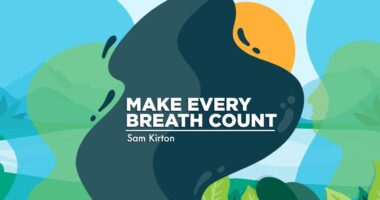A bronchoscopy procedure leads to new ‘adventures’ on my journey
The results underscored the importance of routine health surveillance

My adventure continues. At this point, regular readers might be thinking, “What now?” Some may even pause to make some popcorn before reading further.
I was surprised when I was diagnosed with idiopathic pulmonary fibrosis in 2017, because I had led a relatively healthy life. Deciding to be positive on my journey was absolutely the right choice for me, and it has served me well over the years.
During a routine clinic visit on April 1, I asked for a refill on an albuterol inhaler because I’d been wheezing a little. That’s not necessarily unusual for me during the spring allergy season. After listening to my lungs, the physician assistant told me she wanted me to have a bronchoscopy.
I’ve stopped counting the number of bronchoscopies I’ve had since my bilateral lung transplant in July 2021. During a routine surveillance bronchoscopy in December 2022, doctors noticed that my left primary bronchus (bronchial stem) had narrowed. My healthcare team made several attempts to train my bronchial stem to remain open by using a technique called balloon dilation, but they were unsuccessful. So the decision was made to place a stent.
At that point, my bronchial stem had narrowed to 3 mm when it should’ve been 12-14 mm. Doctors placed a stent in May 2023, and it remained there until that December.
How it went
The results of my recent bronchoscopy were fine. The bronchial stem maintained an appropriate size, and nothing of concern was noted.
Then, about seven hours after the procedure, everything changed. We were at church when I got the chills and my entire body began to vibrate uncontrollably. My wife, Susan, got me home.
I previously had this type of experience twice following a bronchoscopy, so I knew what to expect as it began that afternoon. But this episode, which continued for about 24 hours, set a new benchmark for me.
The sudden onset of chills eventually consumed my entire body and was followed closely by a rising body temperature. The chills became debilitating. Susan covered me with quilts on the couch, but it did little to help. Nausea and vomiting struck randomly throughout the night, and the chills continued into the next morning. My fever reached 101 F before returning to normal the following day. Over the following weekend, I experienced general fatigue.
What happened
First, there was no issue with either the bronchoscopy procedure or the anesthesia. Having experienced this before, it’s more likely that my body recognized something as harmful and tried to fight it. I want to be clear that these episodes have not occurred following every bronchoscopy. As bad as I felt, it was just another part of my journey.
My care team called me on the evening of Easter Sunday, which was unusual. The reason soon became clear: One of the lower respiratory cultures collected during the bronchoscopy had been sent to the lab, and by Sunday, it indicated a moderate growth of Streptococcus pneumoniae. I am now on a 10-day course of Augmentin 875 (amoxicillin/clavulanic acid) and have to get labs done in a week.
I’m not sharing this to scare you away from bronchoscopies, which are a necessary surveillance tool, as demonstrated in this case. They allow my care team to observe the health of my lungs up close. As noted above, the procedure was routine. Thankfully, the bacterial growth was found early and is being treated. Keeping my lungs healthy is how I can make every breath count.
Note: Pulmonary Fibrosis News is strictly a news and information website about the disease. It does not provide medical advice, diagnosis, or treatment. This content is not intended to be a substitute for professional medical advice, diagnosis, or treatment. Always seek the advice of your physician or other qualified health provider with any questions you may have regarding a medical condition. Never disregard professional medical advice or delay in seeking it because of something you have read on this website. The opinions expressed in this column are not those of Pulmonary Fibrosis News or its parent company, Bionews, and are intended to spark discussion about issues pertaining to pulmonary fibrosis.







Jane
I had a bronchoscopy to biopsy an upper left lung nodule. They were not successful in reaching the nodule, but able to test lung tissue. It was clear. I have had 3 years of ct scans on that nodule which has remained stable in size. The unfortunate thing was one vocal cord was damaged during the bronchoscopy and remains paralyzed . I’m fine but sadly can no longer sing very well.
Samuel Kirton
Hi Jane,
Thanks for reading my column and for sharing a bit of your story. Has your team discussed any therapy focused on your vocal cords? My voice does change following a bronchoscopy but seems to revere after a brief period.
Sam...
Ken Fallon
So you are doing well now.!
Daniel Nogueira
Hi Sam, I'm a frequent reader of your posts. Interesting than an IPF ex patient, who supposedly left IPF behind after a bilateral transplant, continues to be engaged with the subject. I live in South America and joined a trial in Mount Sinai NY in last November. Had to stay there for three months returned home and went back to NY this past weekend for a study visit. Will need to return in July and October.
However, the doctors' recommendation is the transplant while I'm in good shape. My understanding is that if everything goes well, I can soon forget about IPF or any other lung related matter. I am uninsured so the big concern is the procedure cost and all the options to use the money otherwise. But then I read your post and realize that lung concerns remain forever. You were transplanted in 2021 and four years later continue to run into issues. I'm in the process of taking a decision and your post is leading me to do nothing. If I will not have a normal life, why not stay the way I am?
Samuel Kirton
Hi Daniel,
Thanks for reading my column and for your comment. The decision to pursue a lung transplant is a personal decision. For me it was the correct choice. In just about two months I will be 4 years post-transplant. The "issues" are an inconvenience more than anything else. Yes, some exacerbations can be serious but my care team quickly addresses any issues. I can tell you that my life experiences which I would have missed without a transplant are gifts. Do not let my experience be the reason you do not pursue a transplant.
If the issue is the lack of insurance consider establishing a GoFundMe type platform fundraiser. Talk to the transplant finance team to get a sense of how much you need to have on hand for the surgery.
Please come back and let me know how you are doing.
Sam...
Daniel Nogueira
Dear Sam,
Please excuse me for taking so long to reply. I mainly want to thank you for taking the time to respond with such kindness and generosity. Regarding my thoughts on a future transplant, they go in several different direction. Thank you for being a lighthouse for all of us in this journey.
Best regards,
Daniel
Samuel Kirton
Daniel,
I hope you return often and let me know how you are doing.
Sam...
J. Philip Jones
Thanks again for sharing your experiences. IPF and lung transplants are really tough sledding. My longtime girlfriend lost her battle in 2021, but because I was so involved in her battle I remain interested in both scientific developments in this area and how people are coping. Finally you write quite well. Think about putting together a book.
Samuel Kirton
Hi Philip,
Thanks for reading my column and your comments. I am sorry that you lost someone you love to the this disease. It is why the community must work to find a cure.
As for the book, writing here reaches many more people including some who may not have access to a book.
Sam...